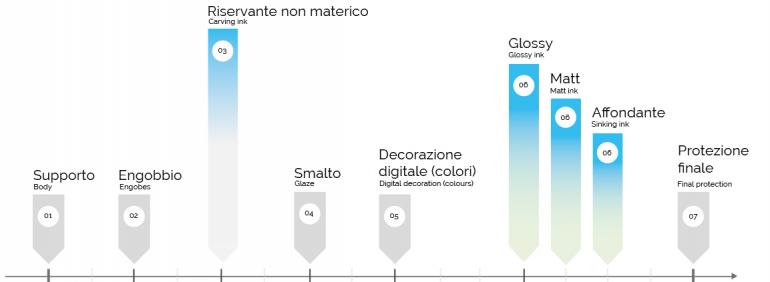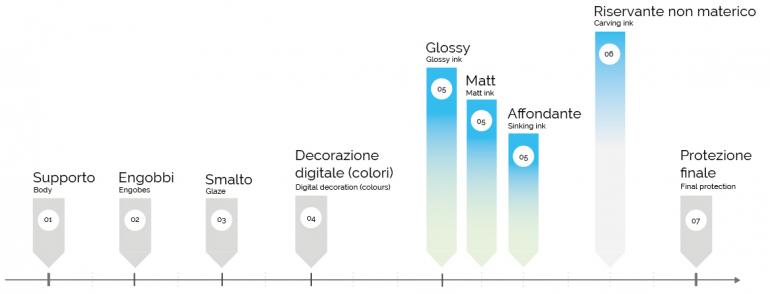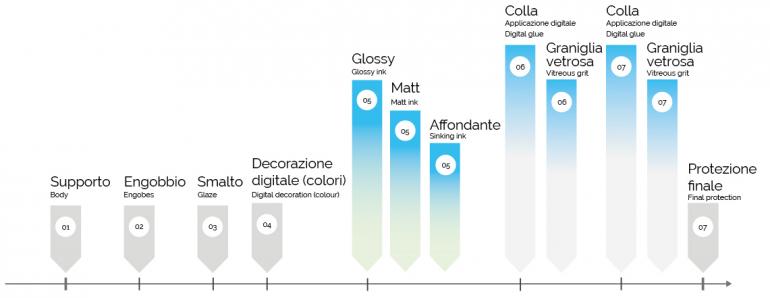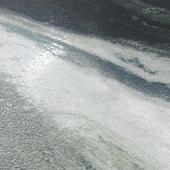Material and structured effects for ceramic surfaces
Inco’s range of digital materials called IDM (Inco Digital Materials) is capable of creating light and surface effects or even full-scale structures synchronised with the digital printing process.

Inco is presenting a wide range of digital materials called IDM (Inco Digital Materials) which are capable of creating light and surface effects or even full-scale structures synchronised with the digital printing process. This results in extremely natural-looking products with unique technical and aesthetic characteristics.
The precision and versatility of the low- and high-discharge digital printing process allows the various material effects and colours to be synchronised, enabling ceramic surface manufacturers to expand their range of products and collections by means of rapid and precise digital applications.
Carving ink
One of the most sophisticated digital materials developed by Inco is its carving ink, a solution that gives the ceramic surface a distinctive torn or textured effect. This creates an exclusive contrast effect with the applied glaze and gives a genuine structure to ceramic surfaces. Carving ink can produce various effects, it can be transparent or white, and it can be applied at the beginning of the line or at the end of the line before the final protection.
Below, a few possible uses are described, simulating a ceramic tile production line.
Figure 1 shows the method of use of Inco whitening carving ink. When applied to the pressed body at the beginning of the line prior to engobe application, it allows a structure to be created. Applying whitening carving ink followed by engobe enhances the contrast between the two in terms of both colour and material. Any engobe applied subsequently to the carving ink will not bond to the area of the tile surface where the ink was applied, thereby creating a real structure on the surface of the tile.

Figure 2 shows the use of carving ink, again used at the beginning of the line, before the application of glaze and digital decorations but in this case after application of engobe. This way the glaze applied immediately after the carving ink will be unable to bond to the ceramic surface in the areas where the carving ink was applied. The glaze will therefore open up to the previously applied engobe (potentially with different colours), creating a three-dimensional effect.

The carving ink can also be applied at the end of the line before the final protection, as shown in Figure 3. This way, the carving ink will resist the glaze of one of the final protections, creating a textured effect caused by the lack of bonding of the glaze to the previously applied digital design of the carving ink.

Digital glue
One of the inks that can be used to create textured and material effects on the tile surface is Inco’s digital glue (Figure 4), which is used to promote bonding of vitreous grit and uniform application over the tile surface. It can be applied full-field or to a digital design to create precise three-dimensional structures.

By using several stand-alone bars at the end of the line (Figure 5), it is also possible to programme the application of multiple grits with different colours or effects (coloured, matt, glossy, white), thereby creating relief effects that interact with each other according to the digital design.

Other digital materials
Along with carving inks and digital glues, Inco’s wide range of digital materials includes products for surface effects such as gloss, matt, white, etc., which are suitable for any ceramic production process. These can be used individually or in combination depending on each manufacturer’s needs and graphic designs (Figure 6).

The digital materials can be positioned on the final bar of the digital printer (after the coloured inks) or on stand-alone bars at the end of the line before the final protection. In greater detail, these are:
- white inks, with high coverage and either a soft or hard final effect after application
- glossy ink, which creates a special light effect on the surface; glossy ink can have different gloss levels according to requirements and is suitable for different ceramic firing cycles;
- sinking ink, which allows precise, colourless cuts to be made on the glaze, creating a drawing-like, textured effect on the surface of the tile;
- matt inks, which produce tiles with a rough surface; these vary in opacity level from white through to completely transparent and perceptible only to the touch.
The availability of such a wide range of digital materials makes it easy for ceramic tile producers to enhance their products with unique and distinctive material, volume or light effects. By coordinating materials and applications, they can harness unlimited new technical and aesthetic potential. Ceramic products once again have the distinctive material look and feel for which they were renowned prior to the advent of digital printing, including increasingly realistic reproductions of wood and natural stone.
Did you find this article useful?
Join the CWW community to receive the most important news from the global ceramic industry every two weeks





















